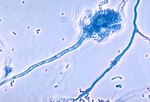This article has multiple issues. Please help improve it or discuss these issues on the talk page. (Learn how and when to remove these messages)
|

Mold health issues refer to the harmful health effects of molds ("moulds" in British English) and their mycotoxins. Approximately 47% of houses in the United States have substantial levels of mold, with over 85% of commercial and office buildings found to have water damage predictive of mold.[1] As many as 21% of asthma cases may result from exposure to mold.[2] Substantial and statistically significant increases in the risks of both respiratory infections and bronchitis have been associated with dampness in homes and the resulting mold.[3]
Molds are ubiquitous in the biosphere, and mold spores are a common component of household and workplace dust. The vast majority of molds are not hazardous to humans, and reaction to molds can vary between individuals, with relatively minor allergic reactions being the most common.[4] The United States Centers for Disease Control and Prevention (CDC) reported in its June 2006 report, 'Mold Prevention Strategies and Possible Health Effects in the Aftermath of Hurricanes and Major Floods,' that "excessive exposure to mold-contaminated materials can cause adverse health effects in susceptible persons regardless of the type of mold or the extent of contamination."[5] When mold spores are present in abnormally high quantities, they can present especially hazardous health risks to humans after prolonged exposure, including allergic reactions or poisoning by mycotoxins,[6] or causing fungal infection (mycosis).[7]
- ^ "Prevalence of Building Dampness | Indoor Air Quality". Lawrence Berkeley National Laboratory. Retrieved 22 August 2022.
- ^ Mudarri D, Fisk WJ (June 2007). "Public health and economic impact of dampness and mold". Indoor Air. 17 (3): 226–235. Bibcode:2007InAir..17..226M. doi:10.1111/j.1600-0668.2007.00474.x. PMID 17542835. S2CID 21709547.
- ^ Fisk WJ, Eliseeva EA, Mendell MJ (November 2010). "Association of residential dampness and mold with respiratory tract infections and bronchitis: a meta-analysis". Environmental Health. 9 (1): 72. Bibcode:2010EnvHe...9...72F. doi:10.1186/1476-069X-9-72. PMC 3000394. PMID 21078183.
- ^ Kathy Orton (October 25, 2013) Mold: What every homeowner fears but probably shouldn’t, The Washington Post, accessed 16 April 2019
- ^ Weinhold B (June 2007). "A spreading concern: inhalational health effects of mold". Environmental Health Perspectives. 115 (6): A300–05. doi:10.1289/ehp.115-a300. PMC 1892134. PMID 17589582.
- ^ Indoor Environmental Quality: Dampness and Mold in Buildings. National Institute for Occupational Safety and Health. August 1, 2008.
- ^ Bush RK, Portnoy JM, Saxon A, Terr AI, Wood RA (February 2006). "The medical effects of mold exposure". The Journal of Allergy and Clinical Immunology. 117 (2): 326–33. doi:10.1016/j.jaci.2005.12.001. PMID 16514772.
